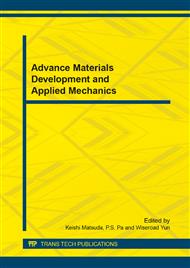p.127
p.131
p.135
p.140
p.144
p.153
p.157
p.161
p.165
Study on the Use of Fleshings-Derived Collagen in Post Tanning Operations
Abstract:
The leather industry generates waste either in solid or liquid form. Fleshing, which is integral part of a hide, is removed during leather processing as it is an unwanted material in the final product. For every ton of leather processed, about 100–150 kg of fleshing is generated. An alternative to disposal of these wastes is to reuse them. In this study, an experimental activity research for assessing the feasibility of the reuse of the collagen hydrolizate in the retanning/dyeing/fatliquoring phase was performed. The hydrolyzed collagen, in liquid form, is obtained by alkaline hydrolysis of fleshings. The hydrolizate has been used both in a vegetable-chrome retannage/dyeing/fatliquoring and in a vegetable retannage/dyeing/fatliquoring to obtain bovine upper leather. Both in a vegetable-chrome retannage and in a vegetable retannage, the final leathers showed similar properties in terms of physical and technical properties to conventionally processed hides. The results obtained indicate that the use of the collagen hydrolizate in the retanning/dyeing/fatliquoring phase as an interesting route for recovering the fleshings.
Info:
Periodical:
Pages:
144-150
Citation:
Online since:
July 2014
Authors:
Keywords:
Price:
Сopyright:
© 2014 Trans Tech Publications Ltd. All Rights Reserved
Share:
Citation:


